2010年05月13日
Sending our letters to the world
After all of our hard work last week making our letters to ask for stamps it was finally time for us to think about sending them out into the world. Over Golden Week for homework everyone wrote out 3 copies of the letter and after some final checking, rewriting some words and rubbing out of pencil marks we decided they were in a good condition to send.
Some letters were really eye catching; there are hand drawn pictures of Mount Fuji and the Japanese flag along with Sakura blossom petals and some original pictures. Everyone really wants to get a reply so they have tried really hard to create the best letter they could, let’s hope that all this hard work pays off!
The next step was to decide where to send our letters to, which proved more difficult that first expected. In order to get a response where should we send the letters? We thought about this and decided that if we sent the letters to schools then maybe some students would be interested and reply to us. This was a good start but of course we had to choose countries to send our letters to as well. Since everyone had written 3 letters we had to choose where to send each one.
After getting out their maps and thinking for a while someone realized: “The letters are in English so we should send one to an English speaking country.”
Everyone agreed, but what countries speak English?
Luckily in everyone’s atlas was a list of information, including language information.
“Look! This country speaks English!” said a few surprised voices.
Of course America, Canada, the UK, Australia and New Zealand come to mind when we talk about English speaking countries but the students were surprised to find so many other.
As a result of this we decided to send the letters out as follows:
* a country the students have heard a lot about, an English speaking country
* a country whose national language is not English
* a country that the students did not know much about, but wanted to find out more
“I want to send a letter to Korea, it’s really close but I don’t know much about it.”
“How about Thailand? I heard they’re having demonstrations so I wonder if the post will get through?”
“Malawi! Where’s Malawi?!”
Some students searched for countries that are difficult to communicate with whereas some searched by looking through their atlas. Most could not explain their reasons for choosing a country, simply that they were curious about it.
Here is the list of our chosen countries.
English speaking countries
Jamaica, Canada, Ireland, South Africa, America, UK, Singapore, India, Australia
Countries whose national language is not English
Russia, France, Korea, Venezuela, Sweden, China, Thailand, Switzerland, Dominica
Countries difficult to communicate with
Saint Lucia, Philippines, Liberia, Antigua and Barbuda, Malawi, Papua New Guinea, Ethiopia, Bahamas
We decided to send letter to 2 schools that we have links to; our sister school in Australia, Fitzroy Community school and the primary school of our native English teacher. However these were really the exceptions, most schools we knew nothing about and of course had to search for them. This is where the internet proves to be a really useful tool. Simply by entering the keywords into a search engine “country name,” “elementary school” and “address” a whole list of schools pop up. These schools are mostly schools in English speaking countries or developed countries. The other types of school that come up in search results are American or International schools or in other words schools where most of the students are not from that country. We did luckily stumble upon a blog of schools that are similar to TCS which gave us a lot of information.
And so with our best wishes and hopes we sent off our letters in the post. We are looking forward to some replies!
Stay tuned for our video letters!
2010年05月14日
映像で世界とつながる
課題は、ネットで住所を調べられたり、ホームページを持っていたりする
学校は、恵まれた国であるということでした。アフリカのリベリアという国
の小学校に手紙を送りたいと考えた子がいて、早速、ネットを使って調べ
たところ、まったくヒットしません。しかし、ネットサーフィンを続けていると、
ピースウィンズジャパンというNPOが、小学校建設支援に関わっていたこと
がわかりました。早速、問い合わせてみたところ、すぐに返事を下さいま
した。その内容は、
「実は、リベリアでは郵便制度がなく、郵便配達人がいない状況にござい
ます。住所はお伝えできますが、郵便制度が機能していません。」
というものでした。
「郵便がなければ手紙送れないよね……」
ある子がつぶやきます。ネットで住所を調べられないどころか、郵便自体
がない国。そこにつながるには、やはり、現地と関わりのある人と出会わ
なければなりません。テクノロジーによってボーダレスワールドになったと
いえども、それは“つながりやすさ”が格段に向上したということであって、
最終的には、人と人とのつながりがカギを握ることは変わりません。
人と人とのつながりを創り出すには、相手の心を動かす「説明」が必要
です。そこで、「直筆の手紙」とは異なった形で相手の心を動かす手法と
して、ビデオレターの作成に取り組みました。ビデオレターは、「画像」と
「音声」によってリアルな感覚を相手に届ける効果があります。
どんなところに住んでいる、どんな人が、どんなことをイメージしてメッセ
ージを伝えようとしているのか
明確になります。「使用済み切手でオリジナルワールドマップを作る!」
という活動に参加してみたいと思わせるビデオメッセージ作りの開始です。
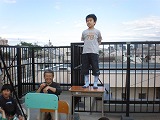
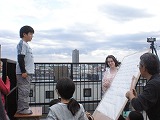
セリフは、英文手紙の文章をそのまま使えます。まずはそれを「なるべく」
暗記する(いざとなったらカメラのそばに置かれたカンペを読めばよいので)。
とはいえ、子どもたちは、カンペばっかり見ていたらカメラ目線にならず訴え
かける力が落ちることをよく自覚していますし、そもそも読み方、発音をしっ
かり覚えておかなければカンペがあっても役立ちません。
「ウィ、ウィ、ウィ……ワ、ワ、ワーン?」
「ちがう、それはワーントじゃなくてウーッド」
「somethingってどう読むの?これ覚えられな~い!」
ペアになってお互いの読み方を聴きあったり、授業終了後も自発的に居残
りして読みの特訓をする子が現れたり、みな手紙の文章を淀みなく読み上げ
られるように必死に取り組みます。単なる英語学習時のような「やらされ感」
が皆無なのは、探究のための必要感があって英語を覚えなければならない
からです。自分がきちんとメッセージを伝えられないと切手集めの活動がうま
くいかないから困る、それはいやだ……という強い動機に突き動かされて
いるのです。
セリフの次は、撮影場所です。
「屋上がいいよ」
「そうだよ、都庁とかのビルを背景にしてとれば東京って感じがでるよ」
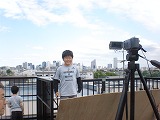
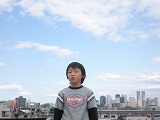
いつもながら素晴らしいアイデアが飛び出します。驚異的な晴れ男・晴れ女
集団のTCSキッズ。撮影当日は、絶好の日和です。しかし、カメラを据えて
みると……フェンスが邪魔してビルが写りません。これでは、子どもたちが
思い描いていた「画像」にはなりません。
「何かに乗って撮れば?」
「そうだ、机とイスだ!」
こういうときに、あきらめずに工夫することこそ“探究する力”です。一瞬に
して状況を把握し、ぱっと飛び散って協力して行動する子どもたち。危なく
ない位置に机を置き、いくつかイスを組み合わせてカメラを載せる台を作り、
モデルとなる子が机の上に立ち、ファインダーをのぞいてみると……
バッチリ!新宿の高層ビル群だけでなく、美しい青空に、ぽっかり浮かぶ
雲。理想的な背景になっています。
「素晴らしい……」
舞台は整いました。いざ、撮影開始!
「3、2、1、アクション!」
「TCS NEEDSs YOUR HELP!」
子どもの声が響き渡ります。
いつになく緊張する子どもたち。他の子が読んでいる最中も自分の番に
備えてカンペを凝視し、口を動かしている子。終わってほっとした子は、
板にはったカンペが風で倒れないように押さえたり、読み方を忘れ、つまった
子に、ささやいて教えたりしています。それなりの長さがあり、決して単語
も簡単ではない英文手紙を、すらすら読める一部の子だけでなく、つっかえ
ながらも自力で全員が読み通したことは快挙です。90分の授業時間内に
9名すべての撮影を完了しました。

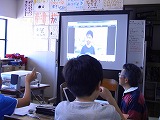
ここまで苦心しながら、なんとか直筆の手紙とビデオメッセージを作成しま
したが、次週は、もう一度、活動の目的に立ち帰って、相手の心を動かし、
協力してみようという気持ちを起こさせるメッセージを提供できたか、人々
を巻き込むためにどんな工夫が必要か、何が足りないのか、再検討します。
RI
※TCS2010年度探究テーマ一覧は、こちらよりご覧ください。
瞬間の感動を詩にする
今週は、最後の「詩人の旅」に出かけました。
「人の温かさに触れる」ため、大田区のまち工場を見学。
電車・バスを乗り継ぎ、京浜島にある橋本鋳造所という鋳物の工場を訪ねました。
ここは、以前にテーマ「詩人の旅」をした先輩たちも訪れた場所です。
最初は、工場の方から「鋳物とは何か」を説明していただきました。
砂でつくった型に溶かした鉄を流し込み、冷まし固めた後、型を崩して鉄を取り出し製品をつくる鋳物。
普段、自分達の目にすることのない機械の部品などに使われているそうです。
説明を聞いて、「鋳物」という言葉も聞いたことがない子どもたちも、
いかなる形でも自在につくることができるという鋳物の特徴に気づいたようでした。
その後、子どもには大きいヘルメットをかぶり、いざ工場を見学!
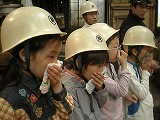 工場内は、型をつくるための材料の独特な臭いが充満して、
工場内は、型をつくるための材料の独特な臭いが充満して、
「くさーい。」
と鼻をおさえたりつまんだりする子ども達。
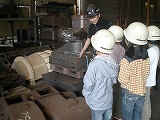
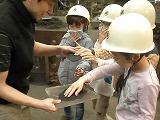
鋳物をつくるための機械、材料の砂や鉄、型(小さなものから大きなものまで)や実際にできた鋳物などいろいろなものを見せてもらいました。
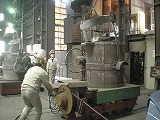 こんな大きな釜に溶かした鉄を流しいれます。鉄の温度はなんと1400度。
こんな大きな釜に溶かした鉄を流しいれます。鉄の温度はなんと1400度。
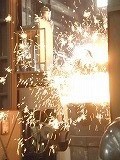 鉄が、注がれる瞬間。
鉄が、注がれる瞬間。
線香花火を何百倍も大きくしたかのような火花が飛び散り、
間近で見ていた子どもたちは怖がりながらも、
その初めて見る景色に目は釘付けになっていました。
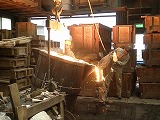
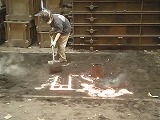
鉄が入った釜を移動し、型に流し込みます。
これは、鋳物の骨組みをつくっているところだそうです。
鉄を冷やすために砂がかけられますが、その砂の下からは湯気がもくもくと立っています。
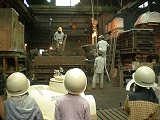
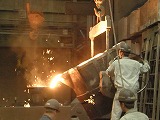
他に子どもたちの印象に残ったのはそこで働く工場の方々です。
溶けた鉄のすぐ傍で、数百キロあるだろう鉄を操り、働く男たちを見て
「命がけだ。」と言っていました。
温かく迎えてくださった橋本鋳造所の皆さま、ありがとうございました!
旅から戻り、感じたことを詩に表します。
鉄が注がれる時に発した火花を見たときの驚きを表現した詩です。
◇◆◇◆◇◆◇◆◇◆◇◆◇◆◇◆◇◆◇◆
火ばな
火ばながズボンまでついた
火ばながちょっとついたからだいじょうぶかなと思った
ぱちょぱちちちちちちちち火ばな
そうぞうい上におどろくことがあるよ
(中略)
火ばながおちていると中にかじになると思ったよ
つくしゅんかんは こんなに遠くまで火ばながとぶかとは思わなかった
ほんとうにビックリしたよ
◇◆◇◆◇◆◇◆◇◆◇◆◇◆◇◆◇◆◇◆
今まで4つの旅をしてきて、たくさんの詩を書き溜めることができました。
でも、「書いたら終わり」ではありません。
自分の感動を表わすのに他の表現はないか、
相手により鮮明にイメージを伝えることができる詩になっているかを幾度となく考え、
推敲する段階に来週から入ります。
EN
※TCS2010年度探究テーマ一覧は、こちらよりご覧ください。
みんなの『うまれてから、ものがたり』
今回のスペシャル探しは、から始まりました。
自分の好きなスポーツ、好きな音楽、自分の宝物などなど
みんなが交代で質問していき、
内面を深く見ていくとその子らしさというものがだんだん見えてきます。
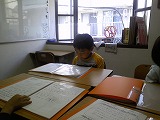
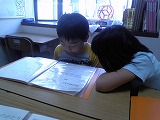
「僕の宝物は、地球、あとお金」
「僕の宝物は、お母さん!」
「らしいねぇ」
「それらのことは幼稚園とかもっと前から変わらないのかな?
「・・・わからない」
「生まれた頃はどんな子のだろう?」
「生まれた場所はね〇〇で生まれたんだって」
「どのくらいの大きさで重さだったのかな?」
「知らない」
生まれた時は記憶もないので詳しくは知りません。
そこで、親御さんにご協力を頂き、それぞれの「生まれてから、ものがたり」という手紙を書いてもらいました。
その手紙を、まず自分達で読んでみます。
何やら、みんなテレながら、笑いながら真剣に読んでいます。
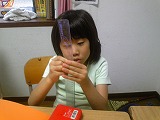 手紙を読みながら、
手紙を読みながら、
「見て、ぼくってね・・・」
このように話しかけてきて、
自分のことを話をしたくてしょうがないという気持ちが強くなったのが伺えます。
ある子が生まれた頃の話を聞いているうちにその子の赤ちゃん時の写真をを見たいと言い出したので、
みんなで持ってこようということになりました。
次のテーマでは、みんなの持ってきた写真を見て、話が弾みました。
「このころから顔は変わらないね。」
「ほんとだ」
「この写真はね、3歳頃の写真だよ」
手形や足形も生まれた当時のものを持ってきました。
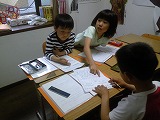
「こんなに小さかったんだ。どのくらい伸びたのかな?」
早速、定規を出してどのくらいかを見てみます。
昔の足形と見比べてみたら、ある子が少しでがかったので、疑問に思い、
どうしてかを考えていたら、生まれた日から少し時間が経っていたことが日付で分かりました。
「これは、何歳のときだ?生まれたのが〇〇年だから・・・」
「□ヶ月?・・・あれ違う?」
年をまたぐと単純なひきざんではなく、1年の12月の周期であることを考えなければいけません。
図に描いてみるとよく分かります。
「じゃぁこれは・・・生まれてから〇ヶ月のときだ!」
生活の中で算数が息づいています。
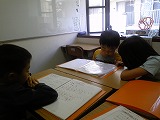
その後も話は弾み、
「僕の見てよ」
「見て、これ・・・」
と、アピール大合戦となりました。
そのことから、自分のことを話すのが楽しいということが伝わってきました。
TK
※TCS2010年度探究テーマ一覧は、こちらよりご覧ください。
2010年05月19日
Our Video Letter
We realised last week that only schools that have a lot of resources have web sites around the world. This led us to think about sending letters to places like Liberia, we could not find any schools with a web site. After a little net surfing however we a school that had been set up by a Japanese NGO called Peace Winds Japan. We thought it best to contact them as soon as possible and we got a reply very shortly which read as follows:
“Liberia does not have a postal system and there are no people who deliver post. We can tell you the address of the school but the postal system is not functioning at the moment.”
Hmm, everyone was very disappointed: “If there is no post then we can’t send a letter…” So we either cannot find an address or there is no postal system. In order to communicate with these countries it seems we must make contact with people who deal with these countries. It seems that there is not necessarily a direct correlation between the advancement of technology and the ease of connecting with others.
In order to make this connection easier, we decided it was necessary to hand write our letters. This way we could really appeal to the reader. We also decided to make a video letter so we could express ourselves through pictures and sound, surely this will move the hearts of those who watch it!
We have to make a video to appeal to people wherever they live, whoever they are. To make people want to participate we need to make an appeal to people who can help us collect world stamps and make an original world map.
We used the letter that we wrote as the basis for the video letter. We wrote the letter out really big so that we could read it if we get stuck…but of course everyone tried to remember as best they could! We all tried to remember the right pronunciation and to look at the camera, and most of all smile. It’s not easy when you have to remember a lot of English!
“W….w….we…wii…?”
“Oh no, that’s would not want….”
“How do you say “something” again..oh I always forget…”
For practice we read in pairs and everyone really tried their best to read the whole letter by themselves without any prompting from others. We read the letter over and over again and eventually we all started to remember it. There was a real feeling of purpose from the students, they wanted to read the letter well and spread their message out into the world, it seems they forgot that it was in English!
After practicing it was finally time to actually film our video letter.
“Let’s go to the roof!”
“Yeah, we can have the view of Shinjuku behind us, that way people will know we’re really in Tokyo!”
As usual everyone is full of ideas. The weather was fine so it seemed like the perfect day to film. When we actually set up the camera though, we realized that the fence was in the way of the picture.
“How about standing on something?”
“I’ll bring a table and chair!”
Everyone springs into action and bring a table just the right height not to be dangerous and chairs to put the camera on. One student offers to be the model and the others look into the camera.
“That’s perfect!” The clear blue sky and the Metropolitan Building in the background look great.
It was time for the actual filming to start. Our top batter stands up and 3,2,1 START!
“TCS needs your help!”
Of course the actual filming is different to the practice; everyone is nervous and finds themselves looking at the letter board more than they need to. The wind suddenly picks up and the letter board nearly blows away, our hair gets in front of our faces, we forget what we are reading or we confuse our sentences but finally after 90 minutes everyone has filmed their video letter!
The strength of the wind surprised us all, maybe next time we can find a way to cut the wind noise, but we hope you can hear most of it!
Our letters have been sent and our video letter filmed. Next week we will be reworking our letters and video letter to see if we can make it appeal to people more.
If you can support us we would be very very happy so please email us!
2010年05月21日
訴える力
ありました。
「いきなり “TCS NEEDS YOUR HELP !” と言われても、TCSがなんだか
わからないかも?」
「このビデオをお父さんが見て、自己紹介があった方がいいって言われた」
苦心して作り、苦労して覚えた英文でしたが、まだまだ改善の余地があり
そうです。
手紙を出してから約2週間。まだ一つも反応がありません。もとより「長期戦」
は覚悟の上ですが、「長期戦」だからこそ、さらに訴える力を磨いてゆきたい。
そんな気持ちに火をつけるために
「この手紙はよくできていると思うけど、まだ完璧ではないよね。多くの人々
に訴えかけて、わたしたちのやろうとしていることに協力したいという気持ち
を引き起こすにはどうしたらよいだろう?」
という問いを投げかけました。
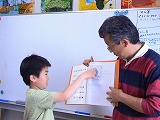
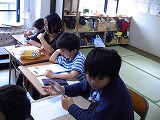
自己紹介の部分を入れること以外に、大きな問題として浮上してきたのが、
「切手」を集めたい理由が弱い!ということでした。
「送ってくれた人もマップ創りに参加しているっていう感じがいいよね」
「じゃあ、どうする?」
「こんな地図ができるって見せたら、ああなるほどって思うんじゃない?」
「そうだよ!ああこんなマップか!って見せたら面白そうだって感じるよ」
集めた切手を使って創るオリジナルワールドマップの完成予想図を作ろうと
いう意見が出てきました。早速、子どもたち各自で、創り上げたい地図の
イメージを考えてみました。すると、大きく2つのイメージに分かれました。
そこで、2つのグループに分けて、模造紙に完成予想図を創ってみる作業に
取り組みました。
1つは、メルカトル図法で正確に世界地図を描き、送られてきた国の切手を
その国の位置に貼るというオーソドックスなものでした。
「国境の線を入れる?」
ある子の提案にみんなが“そうしよう!”とまとまりかけたとき、ゆさぶる問い
をはさみました。
「ぼくたち何のために切手を集めるんだっけ?」
すかさず
「世界の人々とつながるためじゃん」
と当然のような顔で返答してきます。
「国境で区切ることとつながることって一致するかなあ?」
「???」
改めて地図帳を眺めてみると、支配者の思惑で勝手に線を引いたとしか
思えない「直線」で区切られた国境の存在に気がつきます。
「もともと大陸に国境なんかないんだから、このままにしておこうよ!」
国境を描かない世界地図に、何枚も切手を貼ってアルファベットにして、
BORDERLESS WORLD というメッセージを表すことにしました。
もう1つのグループは、地球を描き、その周囲に、いろいろな人種・肌の
色・スタイルの人々が手をつないでいる絵を描きました。さらに、地球の
中に橋を描いて、“つながっている”というイメージを現すことにしました。
「送ってもらった切手を貼って橋を表現するんだ!」
We are friends. というメッセージも載せて、オリジナルワールドマップ創り
への参加を訴える気持ちが伝わってくる完成予想図ができあがりました。
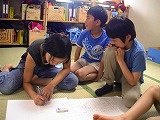
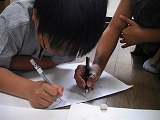
どんなオリジナルワールドマップを作るかというイメージを伝えることで、
「使用済み切手」を必要とする「理由」はより伝わりやすくなったものの、
まだ多くの人々をまきこむには弱い……。使用済み切手には、その国の
文化や有名な物とかが載っていて、それを知ることができるからということ
だけではアピール不足……
「このままだと切手の物々交換だよね……」
誰かがつぶやきます。
「おばあちゃんが古切手集めて寄付してた」
それを耳にして色めき立つ子どもたち。古切手を寄付するとどうなるのか?
子どもたちの関心が高まったところで、事前に用意しておいた資料を配布
します。
「何それ?早く見せて!」
「すごーい。古切手をお金に変えてお医者さんを送るんだって」
「古切手1kgで1200円か……」
みな食い入るように資料に目を通します。
日本キリスト教海外医療教育会という団体が、寄付によって集めた古切手を
切手コレクターに買い取ってもらって得たお金で恵まれない国々に医療従事者
を派遣する活動を行っていることを知りました。
(http://www.jocs.or.jp/jocs/tinyd3+index.htm)
「海外の切手だときっと高く売れるんだよ!」
ある子が、“日本の切手と海外の切手は分けて送ってください”と書いてある
部分を読んで、日本の愛好家ならば海外の切手を欲しがるだろうと推論し、
自分たちが日本国内ではなく海外から使用済み切手を集めることの正当性
を見出しました。
「地図に切手を貼るんでしょ?だったら寄付する分はないんじゃない」
ある子がもっともな疑問を提示します。
「じゃあ、some used stamps だと何枚かっていう感じだから、“できるだけ
多く”って書きかえよう!」
みんなで知恵を出し合って、メッセージの改訂に挑みます。使用済み切手を
集める新たな意義を発見したことで、
We would be happy to send you something from Japan.
の部分の全面改訂が必要になってきました。わたしたちがつながるための
オリジナルワールドマップ作りに協力してくれたらお返しをする……というの
ではなく、恵まれない国に医療従事者を送るために使用済み切手を送って
ほしい!と強く訴えなければなりません。
まず、日本語でメッセージ作りに取り組みます。きちんと「説明」しなくては
内容が伝わらないけれど、反面、相手の心に訴えかける表現でなければ、
相手をまきこむことはできません。難題に直面し、なかなか文をまとめられず
悪戦苦闘する子どもたち。すぐに解が出るようだったら、探究する価値は
ありません。探究型の学びに不可欠な“意味のある停滞”にさしかかり、
授業時間が過ぎたことにも気づかず、頭をひねり続けました。
いよいよ来週は、最終週で、テーマ発表会を迎えます。訴える力をパワー
アップした改訂版ビデオレターを「実演」でみなさまにご披露する予定です。
メッセージを磨き、演じ方も工夫して、いざ発表に臨まん!
RI
※TCS2010年度探究テーマ一覧は、こちらよりご覧ください。
「詩」と向き合う
新宿御苑、隅田川〜築地、鎌倉の海、橋本鋳造所と4つの旅を終えた子どもたち。
旅を通してたくさんの詩が生まれました。
並べてみると、旅を重ねる度に、表現の幅が広がっていることが分かります。
一緒の景色を見ているのに、注目するものも感じることも様々。
一人ひとりの個性が表れています。
でも、もしかしたらもっと別の表現があるかもしれない、
言葉を置き換えると、もっと相手に自分の感動が繋がるものになるかもしれない。
そのためにはどうしたらいいか。
そこで今週は、書きためた詩を整理し、読み直し、推敲する段階に入りました。
今まで旅に出て詩を書くことを繰り返していた子どもたち。
第5週の前半は、有名詩人の詩集、スタッフや子どもたちが書いた詩など、ゆっくり詩に触れる時間を設けました。
まずは、スタッフや子どもたちが持って来た詩集を一緒に楽しみました。
「この詩は、(事実がはっきり書いていないけど)こういうこと?」
と、多くの詩を読み重ねて行く中で、その詩の背景や技などが読み取れるようになったようです。
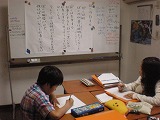
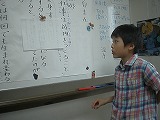
また、スタッフが書いた詩を読んだ時には、
「旅に一緒に行っていない人には分からない。」
とのアドバイスの元、「じゃあ、みんなだったらどんな詩を書くの?」と書き直してもらいました。
発表してみると、元の詩から全然違うものがそれぞれ生まれてみんな驚き!
以前に「詩人の旅」をした先輩のファイルを見てみると、
同じ詩を何回も書いていて、毎回少しずつ変化があり、最初に書いた詩と最終的に出来上がった詩では大きく違っていて。
一つの詩を作るのにここまでのプロセスがあったことを発見しました。
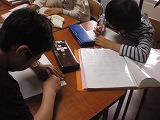 そして、ファイルを整理して、今までどんな詩を書いて来たのかを見直して、一つの詩を選びます。
そして、ファイルを整理して、今までどんな詩を書いて来たのかを見直して、一つの詩を選びます。
ですが、一つに絞るのはなかなか難しく(それはそうですよね、自分が産んだ詩たちですから。)なかなか決まりません。
悩み悩んだ末に、選んだ大切な詩。次は推敲する作業に入ります。
詩に表現されている世界がどんな様子なのか、子どもに詳しく聞いて行きます。
すると、複雑な背景があってその作品ができていることが分かりました。
「でも、まだその世界観が表れていない。どうしたらいいか。」
悩み、書き進まない子もいました。
さぁ来週は、テーマ発表会。
こだわって綴った作品をみんなに披露する機会です。
子どもたちは、「音楽を流したらいいんじゃないかな?」などの意見が出るなど、
どのように発表するかというイメージが少しずつ膨らんで来ているようです。
堂々と楽しんで発表できるよう、しっかり準備してむかえようね!
EN
※TCS2010年度探究テーマ一覧は、こちらよりご覧ください。
自分のスペシャルが知りたい!!
自分のスペシャルを知るためにはどうしたらよいかということを考えました。
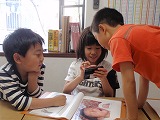
「自分で思い出して考える」
「みんなに聞いてみる」
まずはできることをやってみようということで、自分で考えてみることをしてみました。
どういうことをしたかということから考えてみます。
必死に自分たちの生活から考えてみるものの、一人当たり3つぐらいしか出てきません。
「自分のスペシャルってこのくらいかな?」
と問いかけると
「そんなことはない。まだあるよ!」
という力強い意見。
「でも、分からない・・・」
では、それを知るためにはどうしたらよいだろうか?どうしようか?という議論に再びなりました。
そこで意見でも出ていたように、人に聞くことになりました。そこで、身近な自分の家族に聞くことになりました。
次の日、みんなでシェアをしようということになり、
「聞くのを忘れてしまった・・・」
こうなると学習が進みません。
「自分のスペシャルについて、これだけ分かったことあるから、いいじゃない?」と問いかけると、
「いやだ。もっと知りたい!」と全員が口をそろえて言います。
力強い声でした。
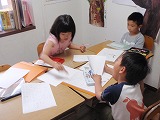
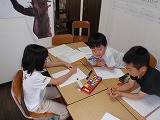
「どうしたらよいのだろう?」かということを自分たちで考えていきました。
他の子どもたちもフォローをしようとみんなで考えていきました。
「もう一度自分たちで考えてみよう!」
「みんなに聞けばよいよ。」
「聞くというのアンケートをとろう」
気持ちが高まっているので、「絶対にやりたい」という意見ばかりでした。
アンケートを自分たちで作成しました。

自分たちでお願い文章から作っていきます。
お願いの文章をみんなで語論をしながら考えるのは大変でしたが、やっとの思いで完成。
次の日に早速スクールのみんなの前でアンケートのお願いしました。
アンケートの結果は、、
ホワイトボード一面にうめつくされて、
自分の気づかなかったことがたくさん出てきました。
来週はいよいよテーマ発表会。今までの自分のスペシャルについてまとめ、自分の思いを伝えていきます。
TK
※TCS2010年度探究テーマ一覧は、こちらよりご覧ください。
2010年05月22日
運動会開催!5/22(土)終了
□□□ 運動会のお知らせ 5/22(土) □□□
「東京コミュニティスクール運動会」が今年も開催されます!
子どもと大人がともに参加し、熱狂に包まれる一日です。
自己ベスト更新とチームの勝利を目指し、子どもたちは、披露するダンスや競技を日々練習しています。
子どもたちの違った一面が見られるはずです。お誘いあわせの上、ぜひお越しください!
●日時:5月22日(土)9:00~15:30頃
●場所:都立赤塚公園 競技場
東京都板橋区高島平3-1
都営地下鉄三田線「高島平」駅から徒歩10分
●雨天決行
(豪雨等により中止の場合は秋に延期。)
※施設内に有料駐車場があります。詳しくは、公園に直接お問い合わせください。
※一般の方の見学・参加も歓迎します。現地でお声かけいただけるとうれしいです。
2010年05月28日
テーマ発表会5/28終了
TCSテーマ学習発表会のご案内
東京コミュニティスクール(TCS)のテーマ学習では、1年間に6つの探究領域を学びます。ひとつの探究領域のもとでクラス毎にテーマが設定され、約6週間単位で活動が行われていきます。
(参照:探究テーマ一覧表)
テーマ発表会は、その6つのテーマ学習ごとに設けられており、保護者だけでなく、一般の方々にも参加していただける機会になっています。
(ご希望の方は、下記要領にてお申込みください。)
子どもたちは、どのようなプロセスで、どのようなことを学んでいるのか・・・。
ぜひ、直接子どもたちの様子を見に来てください。
記
【日時】 2010年5月28日(金) 9:30~11:30(予定)
【場所】 セシオン杉並
(東京メトロ丸の内線「東高円寺」駅 徒歩5分)
(東京都杉並区梅里1丁目22−32)
地図は、こちら
【進行】(予定)
9:30 ~ 9:40 イントロダクション
9:40~10:10 ツバサ(1、2年)「I am Special!」
10:10~10:40 楽生優笑(3、4年)「詩人の旅」
10:40~10:50 休憩
10:50~11:20 5、6年「ボーダレスワールド」
11:20〜 総評、片付け
※発表までの6週間、子どもたちが学んできた様子の詳細は、探究テーマ一覧表よりご覧ください。
【お申込み・お問合せ】
東京コミュニティスクール
E-mail:school@tokyocs.org
TEL:03-3313-8717
※迷惑メール防止のため、「@」を全角にしております。お手数ですが、半角に変更してから送信してください。
お申込みの際は、
件名に、「テーマ学習発表会参加希望」とし、
本文に、以下の事項をお知らせください。
1.参加者氏名(すべて記入ください)
2.(保護者の方は)お子さんの現学年
3.E-mailアドレス
4.電話番号(最も連絡のとりやすい番号)
5.TCSを知った経緯(知人、ネット検索、新聞名・雑誌名など)
6.質問事項等(あれば)
終わりが始まり
これを、テーマ発表会で「披露」し、聴衆からフィードバックをもらい、さらに
改善して「録画」に臨むことにしています。
相手の心に訴えるには「内容」だけでなく、どう「演じる」かがとても大事だ
ということは、前回のビデオレター撮影で気づいていたポイントでした。
そこで子どもたちはどう演じてこの英文を発表するか考えました。
「最初と最後は全員一緒に読んだ方がいいよね」
「最後の文を読むときには、なんか身振り入れた方がいいよ」
「じゃあ、the better のときは手を下げて広げて、We can change the
world ! って最後に決めるときは上に思いっきり手を広げよう」
最初に印象づけるセリフと最後の決めゼリフは、みんなで言う。その他の
部分は、分担する。ただそれだけでなく、声の大きさや調子、演じ方を
工夫して読まないとダメだ……
英語を暗記できていればよいという気持ちではなく、メッセージを効果的
に伝えたい!という強い思いを子どもたちは共有しています。最初の並び
方はどうするか、どんな視線だと聴衆の心により届きやすいか……一つ
一つの動作も気になり、意見をぶつけ合います。話し合っているだけでは
埒があかないときは、とにかくやってみて、その結果を見て判断しました。
知恵を出し合い、試行錯誤しながら、演じ方を固めてゆく子どもたちの姿を
見て、子どもたちが主体的に取り組む活動になっていることがよくわかり
ました。
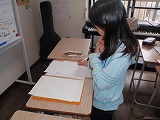
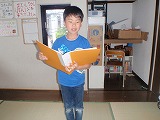
英文を手紙として書いたり、ビデオレターの撮影のために覚えたり、
繰り返し触れざるを得なかったおかげで、言い換えれば、ここまでさんざん
苦労してきたおかげで、英語はほぼ頭に入っていました。このため、発表
スタイルを固めた後のリハーサルはすんなり終わりました。
ただ、今回は、いつものテーマ学習以上に、発表会が済めば“終わり”
ではありません。
「切手が送られてきたらワールドマップに貼る」
「それは当然だね……」
「もし来ない場合は、別の手紙を書いたり、別の場所に送ったりしなきゃ
ならないよね」
放課後などの空き時間を利用して活動を続けてゆくには何をすべきか…
「JOCSも訪問しようよ」
ネットで得た資料だけで理解するのではなく、直接、JOCSの事務所に
出向いて、活動の趣旨や内容をインタビューし、さらに自分たちがやろうと
していることに対する意見をもらうことにしました。
「お礼の手紙というか、返事を出して友達になりたいな」
1回やりとりして終わりではなく、つながりを深めたいという意見も出ました。
いずれにせよ、動き出した以上、もう後戻りはできません。TCS開校以来
最大のビッグプロジェクトといっても過言ではない活動をどう責任感を持って
維持してゆくかが問われます。
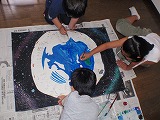
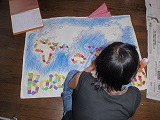
テーマ発表では、今回の学びの目的、学びの流れ、英文ビデオレターの
実演、今後続けたいことについて、わかりやすく、しっかり説明できました。
特に、英文ビデオレターについては、臆することなく、思いっきり訴えよう
という気持ちが全面に出ていて、聴衆から好意的なフィードバックを得て
いました。
しかし……まだ、「つながることができるかも」という“妄想”に過ぎず、
「つながることができる!」と“実証”していません。達成感もありながら、
それ以上に、今後に向けての期待と緊張感を子どもたちが強く抱いている
ことをテーマ発表後のふりかえりでわかりました。
「ぼくたちが卒業した後も後輩達に続けてもらわないとな……」
まず、つながる実感を得ること。そして、つながり続けるということ。
その先に、最初は想像することするらできなかった「チェンジ」があるに
違いない……
終わりではなく、いよいよここから、「つながる」ための本当の努力の始まり
です。
RI
※TCS2010年度探究テーマ一覧は、こちらよりご覧ください。
「詩」で伝える
テーマ「詩人の旅」、最終週。
今まで、旅で見たもの感じたものをどんどん詩として表現してきた子どもたち。
でも、それらの詩を仲間と披露し合うことはあっても、
多くの人に聞いてもらう機会はありませんでした。
自分が作った詩は、相手にそのイメージや感動を伝えることができるのか。
今週はテーマ発表会に向けて、その挑戦の時間となりました。
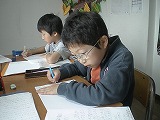
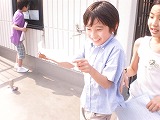
発表練習を重ねるにつれて、
先週に推敲したはずの詩も、何度も読むうちに
「こうしたほうがいいかも。」
と、書き直す姿が見られたり、
発表の方法も、
「こうしたらどうかな。」
と試案する、
そんな、こだわる姿が見られるようになりました。
そして、発表会当日。
本番直前の練習では,
前日までなかなか覚えられなかった子どもも、お家で何回も練習してきたようで、
バッチリ覚えていました。
ここまでやったら、あとは、堂々と楽しんで発表しよう!
円陣組んで、「行くぞー!」
発表本番は、緊張しつつも、楽しそうに詩を朗読している様子が伝わりました。
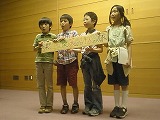
マイクを使わずの発表だったので、緊張もあってか、
練習より声が小さくなってしまったように感じましたが、
扇風機を浴びて桜に吹く風についての詩を発表したり、
音を取り入れたりと、それぞれが工夫した発表をしていました。
また、自分以外の発表の時には衝立の後ろに隠れる予定であったのに、
そこから離れて仲間の発表を
「ちゃんと言えるかなぁ」
と、食い入る姿を見て、発表は一人ひとりでも、
クラス全員で作った発表になっていたと感じられました。
終わった後の子ども達の表情は、安心したような穏やかな表情でした。
EN
※TCS2010年度探究テーマ一覧は、こちらよりご覧ください。
みんなにスペシャル伝えたい!!
いよいよ今週の金曜日がテーマ発表会。
発表会に向けて、ラストスパートです。
自分自身のスペシャルなことをひとつの図にまとめました。
今までスペシャル探しで描きためた手形や足形、姿絵などを使いました。
さらに、自分の伝えたいスペシャルを取捨選択していきました。
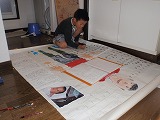
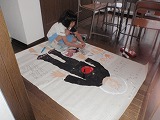
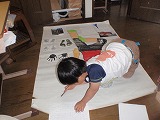
掲示するスペシャルな図はできたので、早速、発表の練習です。
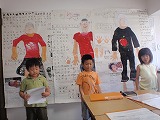
1年生は、はじめてのテーマ発表。
どのようにすればよいか
2年生の先輩二人に優しく教えてくれるように頼むと・・・
「大きな声でゆっくりと言えばいいんだよ」
「下ばっか見ないでみんなの方を見て言う」
ということが挙がり、見本を見せてもらいました。
とても大きな声で力強い声が響きわたります。
それで自分たちのスペシャルなものに対する伝えたいという気持ちを伝えられるか?
少しずつ修正を加えました。
まだまだ思いを伝えるには何か足りないかな?と考えらながら練習を重ねました。
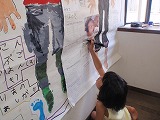
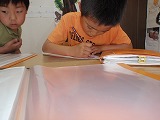
本番では、この伝えたいという強い思いは通ずるのでしょうか?
TK
※TCS2010年度探究テーマ一覧は、こちらよりご覧ください。
Putting the Stamps to Good Use
After watching back our video letters there were several things we wanted to improve.
“We say “TCS needs your help” but people won’t know what TCS is…”
“When my Dad watched the video he said he thought we should do a self introduction”
We realized that the English we had tried so hard to remember wasn’t quite enough; we still needed to ask more.
It has been about 2 weeks since we sent the first lot of letters, and we haven’t had a single reply. We know that the project is a long term project but we don’t want to lose momentum or hope. To spark their enthusiasm again the teacher suggested that the letter could still be improved.
“The letter you wrote is very good, but it isn’t perfect yet. What can we do to really move people to help us out?” he asked.
In addition to inserting a self introduction paragraph the students realized that simply saying our “collecting stamps and making a map” idea will not be enough to spur people into action.
“I think we should give people who send us stamps the feeling that they are really participating in making the map”
“So what do you think we can do?”
“We could actually show them our idea”
“Yeah, it will have more impact if people can see an example of what we want to make!”
This led to a series of quick and sometimes heated discussions about what kind of map to make and the class eventually broke into 2 groups. These groups then made an example map on large pieces of paper.
The first group’s map was based on the Mercator projection style map and involved putting sent stamps onto the country where they come from.
“Should we draw country borders?” asked one student.
Which is when we posed the question: “Why are collecting stamps again?”
“So we can connect with people all over the world….” came the reply.
“So do you think that country borders really encourage the spirit of the theme?
“Huh?????”
When we looked at the map again we noticed the dead straight lines between countries and though this was strange.
“But if course you can’t see these lines in real life! Let’s leave them off!”
Under the borderless map the students decided to write “BORDERLESS WORLD” in English.
The other group on the other hand chose to draw the globe of the Earth with people around the edges holding hands. There are bridges connecting the countries on the map to represent connecting with each other.
“The bridges can be made out of the stamps that people send us!”
The map was completed with the message “We are friends.” This map really showed the essence of our theme and will really catch the eye of people around the world.
After completing the map we started to think in detail about our message, the reason for wanting to collect world stamps. The problem of our message being a bit vague came back to mind. Of course we want to know about other country’s culture and famous things but that is not all.
“If we just ask people to send stamps it becomes just an exchange of things…”
“My grandmother used to collect stamps” says one student suddenly.
In preparation we had found an NGO which puts used stamps into good use so we showed them the information.
“Wow, they change the used stamps into money and send it to doctors in foreign countries…”
“1kg of stamps is worth 1,200yen”
Japan Overseas Christian Medical Cooperative Service (or JOCS) is a Christian NGO which sells old used stamps to collectors and uses the money to provide doctors and medical staff to countries in need.
Click here to see the JOCS website
“Stamps from outside Japan fetch more money!” said one student after reading the pamphlet. JOCS asks for domestic and international stamps to be separated and we realized that we really need to collect stamps from abroad so we can help others.
“We have only said we will put the stamps onto the map” notices one student.
“So…instead of sending some stamps we actually would like people to send as many stamps as they can!”
We decided then to change this, along with the sentence that reads “we would be happy to send you something from Japan.” Instead we need to explain about the charity and what good use the stamps will be put to. This way we can really connect with people all over the world and help people less fortunate than ourselves.
To start with we wrote this part out in Japanese but found it very difficult to make it compact and accurate and before we knew it class should have finished 15 minutes ago!
The next step was to change this in English and reshoot our video letter…stay tuned for more!
If you think you can send stamps to us please send an email to school@tokyocs.org
2010年05月29日
『ボーダレスワールド』~ふりかえり~
という意識の芽生えを促すことが今回の学びの目的でした。テレビやインター
ネットからあふれでる2次情報にどっぷりつかっている子どもたちは、なんとなく
海の向こうの国々について「知ったつもり」「わかったつもり」になっています。
「テレビでやってたけど、〇〇人ってバカなことばっかりするんだよね」
「△△って貧しくて、水道がないところだからかわいそうだよね」
なんとなく見聞きした2次情報で先入観が作られています。そんな子どもたちが
ネットという「ツール」を活用しつつ、物理的に大きく離れた人たちと手紙を介して
直に“つながる”ことを企てました。
相手が小学生ならば自分たちの思いを理解してくれるのではないか……
じゃあ、小学校に送ってみよう!と発想する。そこで、TCSと似たタイプの学校を
「ネットサーフィン」して探す……いろいろな検索キーワードを試し、学校のHPだけ
でなく、個人のブログや、世界のオルタナティヴスクールについてまとめたHPから
も情報を見つけ出す……ひょんなことで面白い学校を発見し、手紙を出すことに
決める!直につながるために、ボーダレスに世界をつなぐインターネット情報を
いかに活用するか学んだことは、今回、子どもたちにとって大きな収穫でした。
「ツール」の活用法を学んだという観点からすれば、「インターネット」だけでなく
「ツール」として「外国語」を学習したことも、有意義なことでした。テーマ発表の
際に、英文ビデオレターで撮影すべき内容を実演することにしましたが、子ども
たちはその部分の練習が予想に反してすんなり終わったことに驚いていました。
英語で文を作ったり、読んだり、覚えたりするところはとても大変だった。
でも、なんか知らないうちに読めるようになったり、覚えたりできるようになった。
そのときに、自分なりに工夫して覚えた。
という感想が、ふりかえりのときに子どもたちから出ました。
学ぶ過程での「大変さ」が、英語嫌いにつながらず、かえって英語獲得への
執念を引き出したのは、「機械的な作業」ではなく、「獲得する意義」を見出
した上での「大変さ」だったからだと言えましょう。目的達成のための「ツール」
として英語を必要としたことが、負荷の大変さを乗り越え、どうやって英語を
ものにするか、どうしたらもっと英語をうまく使うことができるか、という動機づけ
を生みました。外国語の学習は、使う必然性のある状況で、本人が獲得したい
という意欲を持った上で行うものです。したがって、探究のための「ツール」として
外国語を必要とするような学びを仕組むことがとても重要だということを改めて
痛感しました。
自分が動けば何かが変わる……という実感を得るところまでは、テーマ学習の
期間中には到達できませんでしたが、用いる言葉一つ一つに細やかな神経を
使うことの重要性についてじっくり議論できたことで、「時空因縁」という探究領域
で身につけたい視点を養うことにつながったと感じています。それは、不用意な
一言が「騒乱」の引き金になり、歴史を変えてしまうことがあるからです。また、
一般民衆の偏見や根拠のないデマの流布が、社会を混乱に陥らせてしまうから
です。たかが言葉でありながら、政治家の一言、世論を形成する一言が、時代
を動かしかねない……だからこそ私たちは、たとえ善意に端を発したものであっ
ても、相手の立場に自らを置いてみて、自らの発言を組み立ててゆくという慎重
な思考スタイルを磨き続けなければならない。今後も続けてゆく活動を通じて、
さらにこれらのことについて子どもたちと議論を深めてゆくつもりです。
RI
※TCS2010年度探究テーマ一覧は、こちらよりご覧ください。
『詩人の旅』〜ふりかえり〜
テーマ「詩人の旅」。
6週間の間で、詩を楽しく書くことができるようになったと感じます。
最初は、「詩って何?」から始まった学び。
多くの詩に触れて、旅に出る中で自分でいろいろと書いてみて、
自分なりの詩のかたちがつくれるようになりました。
本テーマでは、4度の旅に出かけました。
身近な自然に触れた「新宿御苑」、
街の情景に触れた「隅田川・築地」、
自然の雄大さに触れた「鎌倉の海」、
人の温かさに触れた「橋本鋳造所」(鋳物工場)。
ほぼ毎週旅に出て、子どもたちにはハードだったかもしれません。
しかし、たくさんの情景に触れたことでたくさんの感動を得て、
詩の材料を得ることができました。
子どもたちから出て来た言葉たちは素直で、
そして、詩人の技を活用することで、
一人ひとり違う、子どもたちの個性が表れる詩となっていました。
最初は、自分から出て来た言葉を綴ったものでしたが、
発表会が近づくにつれて「相手に伝わるには?」ということを意識するようになった子どもたち。
このことは、本テーマに限らずどのテーマでも重要なことです。
わかったこと、やったことだけを伝えるのではなく、
「聴いて!」「伝えたい!」というエモーショナルな発表を
これからもつくっていこうね!
EN
※TCS2010年度探究テーマ一覧は、こちらよりご覧ください。
みんな聞いて!僕らのスペシャル!! 「I am Special」~ふりかえり~
テーマ発表本番の日になりました。
当日の朝のぎりぎりまで練習を重ねてきた成果は、はたして?
『大きな声でゆっくりとはっきりと』ということに気をつけて、いざ発表。
今までテーマで学習してきた流れを伝えていきました。
自分のうまれてからものがたりを伝える場面では・・・
「これが生まれてからすぐの写真です。どうです?かわいいでしょ!」
思わず会場から笑いが噴出しました。
それぞれのうまれてからものがたり、自分のスペシャルを発表の時には笑いもおき、
会場の人たちが「らしいなぁ」と思うような場面もあり、とても和やかな雰囲気でした。
質問に対しても、自信を持って「これが一番のスペシャルです」と言える姿からも、
自分がいろいろな人に愛されていきているのを実感している姿がうかがえます。
発表が終わってのふりかえりの時間では、
今回のテーマ発表で、頑張ったという自負があるようで、
振り返りシートが楽しみで仕方ありません。
授業が始まるとすぐに自分たちでみんなで読み出しました。
「声の大きさ・・・できてる・・・はやさ・・・できてる・・・」
「イエーイ パーフェクト!!」
お互いに手を叩きあって喜んでいて
「できている」ということが多く嬉しそうでした。
最後に
「でもスペシャルなことってこんなもんでしょ?」
と質問すると
「ぜったいそんなことないもっとあるよ!!」
と力強い反論。
もっともっとスペシャルを探したいという意欲を強く感じることができました。
みんな一人一人かけがえのない存在。
スペシャル探しは一生続いていきます。
TK
※TCS2010年度探究テーマ一覧は、こちらよりご覧ください。
2010年05月30日
TCS大運動会!!終了
5月22日、TCSのイべントの一つ大運動会が行われました。
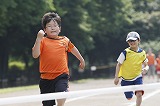
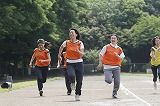
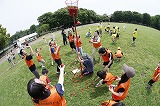
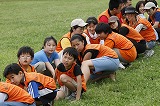
快晴に恵まれた会場にはたくさんの保護者も集まり
『自己ベストに挑戦』のテーマのもと、日頃の練習に励んできた子供たちには、
まさに最高の舞台。
イエローソックス対ファイヤーバズーカの決戦が始まる。
最初の競技の50m走から自己ベストめざしエンジン全開。
記録を狙う種目はほかに、走り幅跳び・ソフトボール投げ・1200m走。
どの競技でも、子供たちはみな自己ベスト更新、あるいは、
自分のチームの勝利を目指し真剣そのもの。
そして歓喜、悔し涙。
親子で競うほほえましい光景の台風リレー、保護者とスタッフが対戦する
1200mリレーなどを間にはさみつつ競技は進む。
お昼休憩の後、子供たちのダンスを観て楽しんでから競技再開。
後半戦いはますます熱を帯び、応援もしだいにヒートアップ。
激しいボールの奪い合いのミニサッカー、そして、いよいよ勝敗を決する
最終種目の綱引きへと手に汗をにぎる熱戦が繰り広げられました。
対抗戦はイエローソックスの勝利。
しかし、子供たちはみな広い空間で、のびのびと体を動かし全力を出し切り、
その表情は満足げで誇らしげであったのが印象的でした。
たくさんの自己記録更新を残し、実りある運動会の幕は閉じました。
みなさん、お疲れ様でした。
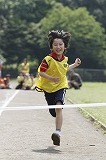
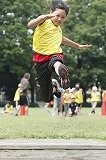
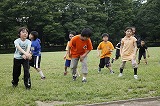
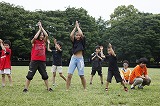
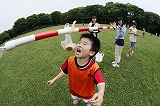
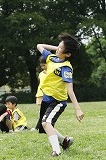

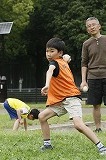

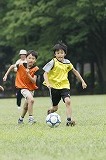
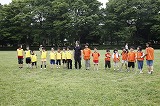
カテゴリー一覧
- 2015年04月
- 2015年03月
- 2015年02月
- 2015年01月
- 2014年12月
- 2014年11月
- 2014年10月
- 2014年09月
- 2014年08月
- 2014年07月
- 2014年06月
- 2014年05月
- 2014年04月
- 2014年03月
- 2014年02月
- 2014年01月
- 2013年12月
- 2013年11月
- 2013年10月
- 2013年09月
- 2013年07月
- 2013年06月
- 2013年05月
- 2013年04月
- 2013年03月
- 2013年02月
- 2013年01月
- 2012年12月
- 2012年11月
- 2012年10月
- 2012年09月
- 2012年07月
- 2012年06月
- 2012年05月
- 2012年04月
- 2012年03月
- 2012年02月
- 2012年01月
- 2011年12月
- 2011年11月
- 2011年10月
- 2011年09月
- 2011年07月
- 2011年06月
- 2011年05月
- 2011年04月
- 2011年03月
- 2011年02月
- 2011年01月
- 2010年12月
- 2010年11月
- 2010年10月
- 2010年09月
- 2010年07月
- 2010年06月
- 2010年05月
- 2010年04月
- 2010年03月
- 2010年02月
- 2010年01月
- 2009年12月
- 2009年11月
- 2009年10月
- 2009年09月
- 2009年08月
- 2009年07月
- 2009年06月
- 2009年05月
- 2009年04月
- 2009年03月
- 2009年02月
- 2009年01月
- 2008年12月
- 2008年11月
- 2008年10月
- 2008年09月
- 2008年08月
- 2008年07月
- 2008年06月
- 2008年05月
- 2008年04月
- 2008年03月
- 2008年02月
- 2008年01月
- 2007年12月
- 2007年11月
- 2007年09月
- 2007年07月
- 2007年05月
- 2006年12月
- 2006年11月
- 2006年09月
- 2006年06月
- 2005年12月
NPO Tokyo Community School
特定非営利活動法人 東京コミュニティスクール
〒164-0001 東京都中野区中野1-62-10
TEL: 03-5989-1869 FAX: 03-5989-1649
e-mail: school@tokyocs.org
